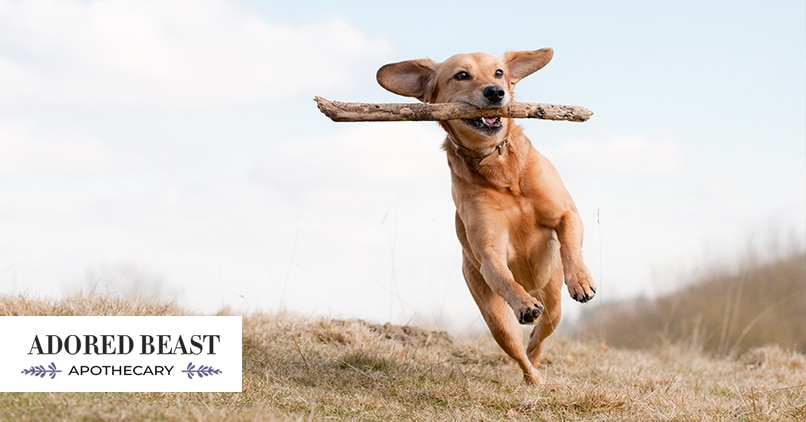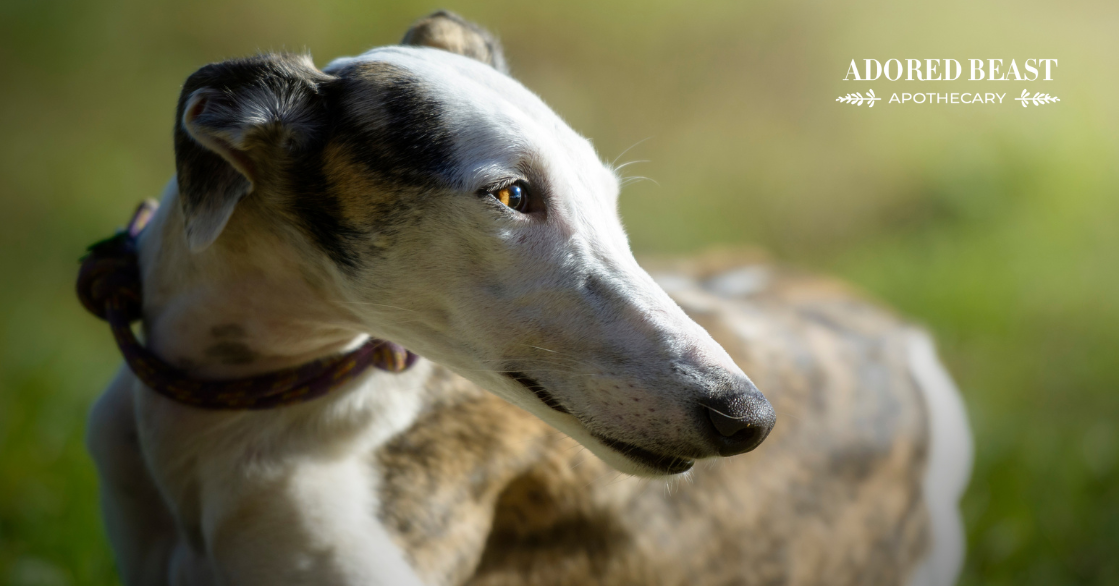I want to talk about the scaffolding of orthopaedics and the importance of prevention and supportive care of arthritis and joint health.
When it comes to arthritis in dogs (or any animal, really), most people are looking for solutions to support joint health, inflammation, and pain. We’re so lucky that there is a huge array of wonderful natural supports out there to address joint health and disease.
But how does the actual body support your animal’s joints, spine, and bones? That’s a really important part of the discussion that I don’t want you to forget about or ignore!
Every muscle has an interwoven connective tissue that attaches the muscle fibres and bundles together. If you picture muscles as a large, ornate stained glass window, the fibres and bundles would be the different-sized colourful glass panels. The surrounding and supporting connective tissue would be the surrounding and supporting lead in the windows. This connective tissue, which looks like steak gristle in large bundles, is composed of collagen strands that give it a tremendous ability to withstand pulling or longitudinal strains. It also has limited elasticity, which allows it to stretch while still holding the tissues together. Without the connective tissue holding the muscles together, your furry friend would lose his strength and the ability to move his bones or support his frame.
Everyone has heard the term muscular-skeletal system but the leading or keyword here is muscular!
Skeletal Muscles and Movement
The joints, limbs, bone, and muscles are specialized tissues within the body that serve their purpose primarily by contracting. This is accomplished when muscle tissue employs the proteins actin and myosin, which slide past each other to create movement. Highly-developed skeletal muscles are also associated with strength, and can be toned and improved through regular exercise.
All muscles in the body work by contracting to create movement. When we think of the muscular system, our first thoughts go primarily to the skeletal muscles that are the actual reason the limbs can move at all! By working in pairs, muscles contract and relax in tandem to raise and lower limbs or to bend them at joints. When your animal’s leg bends, for example, his hamstring contracts and relaxes the quadriceps. Relaxing the hamstring allows him to straighten his leg and so on with all the different muscle groups.
In many cases, skeletal muscle contraction maintains body posture and position. For example, when all of a sudden your dog or cat stares at a mouse or a squirrel, (we have all seen this), well the muscles in her abdominal wall and pelvis contract to maintain that centred stance.
In essence, besides controlling movement, the muscles are a major part of the body that prevents all the weight from being solely supported by joint and bone. Unhealthy muscle tissue leads to the increase of wear and tear, leading to earlier deterioration inflammation and arthritis.
This is huge when it comes to movement and pain BUT that’s not all the skeletal muscles do!!!
Did you know that skeletal muscle does more than just move body parts? Skeletal muscles are also used for posture, swallowing, defecation, urination and homeostasis.
Skeletal Muscles Functions
Your pet’s skeletal muscles serve a variety of functions: the support and movement of the skeletal system (as we discussed above), but additionally, skeletal muscles help with nutrition and temperature regulation and homeostasis (I’ll go over that more in a bit).
The energy from skeletal muscle contractions produces heat and regulates body temperature.
The sphincter is a perfect example. The sphincter is a special type of skeletal muscle that regulates the opening of the digestive and urinary systems. A sphincter is an organ composed of muscle that surrounds a hollow organ, much like a rubber band would wrap around a plastic tube. Intestines and blood vessels are examples of hollow organs. The sphincters at the ends of the digestive and urinary systems are composed of skeletal muscle and provide conscious control of swallowing, defecation and urination. For example, the anus contains a sphincter that, when contracted, prevents defecation, or, in the case of spay incontinence or age-related urinary leakage, which is caused by the lack of sphincter tone of the urethra. Sphincters are not only composed of skeletal muscles though. There are also smooth muscle sphincters that are under the influence of the autonomic system or involuntary nervous system. It really is very cool!
Homeostasis
In addition to providing support and movement, skeletal muscles are necessary for some homeostatic functions. Homeostasis is the maintenance of a relatively constant internal environment. If you have ever shivered in the cold, you are familiar with one of these functions – that is, temperature regulation.
Skeletal muscle contraction requires energy. As energy is used to contract muscles, much of that energy is converted to heat, and heat helps to maintain relatively constant body temperature. Because much of the body is skeletal muscle, this provides an effective means of temperature regulation. In fact, shivering thermogenesis is the rapid contraction of muscles for the purpose of generating heat. Therefore, skeletal muscle helps with homeostatic regulation of body temperature.
Last but not least, while it is not a skeletal muscle let’s not forget the major muscle THE HEART and the small amount of muscle that is part of the brain that actually stimulates the nervous system to trigger the muscle to function and the limbs to move!
Now that we know how VITAL muscle heath is, not only for joint health but for life and health in general, what are some ways that we can keep them healthy?
How to Support Your Furry Friend’s Muscles
These are some of the best recommendations to support the muscles and prevent or improve arthritis in dogs, and can easily be added to your animal’s daily diet.
- Vitamin C – Unlike humans, dogs, cats and horses make their own Vitamin C. However, if your dog’s immune system is at all compromised by over vaccinations, stress, injury, unhealthy gut flora, etc.. then the there is a concern they can lack Vitamin C. The good news is, there is Vitamin C in RAW MEAT!!! With horses, I recommend adding a human grade natural Vitamin C to the diet in times of stress, illness or injury. Things like Swiss chard and spinach are high in Vitamin C, so add those to your dog’s diet. With your cats, a FULL raw meat diet will provide the adequate amount needed.
- Vitamin B – Eggs, lean meats, legumes, nuts, and leafy greens are all high in Vitamin B.
- Vitamin D – Make sure to spend lots of time outside in the sunshine with your pup, and add beef liver, wild salmon, raw milk and egg yolks to her diet.
- Vitamin E – I personally feed my dogs raw soaked almonds as treats, but other foods high in Vitamin E include sunflower seeds, spinach, avocados, squash, trout, shrimp, olive oil, hemp seed oil, and broccoli. I give my horses a handful of sunflower seeds 2-3 times a week.
- Omega 3s and Amino Acids – Feeding whole fish or phytoplankton, are easy ways to up the omega 3s in your animal’s diet. Phytoplankton are tiny, microscopic plants that form the base of the food chain in the ocean. It’s one of the most valuable sources of nutrition on earth and it’s chock full of essential amino acids, and it’s great for cats and horses too!
These next two, calcium and magnesium, are really important because they work together in the supportive absorption of each other! You can easily have too much or too little of one that can actually look like arthritis with your dog but in fact is a deficiency of either of the two! - Calcium – Raw milk and digestible bone (chicken and turkey necks are awesome) are two great sources of calcium.
- Magnesium – Here we go again – Swiss chard, spinach and almonds! Horses are often really low in magnesium, and there are some great supplements out there but be sure they are NOT SYNTHETIC!
- Quality Protein – In Chinese medicine, there is a strong belief in feeding what you are trying to support, so in this case muscle meat, heart, etc. Try and get ETHICALLY raised animals as much as you possibly can!
- Collagen – This supports the connective tissue (think of the lead glass description I made earlier, or you can look at it as the scaffolding that holds the joints and bones in its supportive positions)! BONE BROTH, BONE BROTH, BONE BROTH!!!! It’s easy and inexpensive to make!!! Phytoplankton has a plant-based collagen as well and horses do amazing on it. Even cats LOVE it!
- N-Dimethylglycine (DMG) – The last thing I would like to talk about is the use of DMG in my practise. Any dogs or horses that were high performance (like agility or fly ball or working or endurance horses, jumpers, barrel racers or race horses) ALL went on DMG, but so did all aging dogs, cats and horses to support muscle health or when they already had arthritis. Many, many times the results were incredible, which says to me that they were not only experiencing joint pain but also muscle fatigue, muscle stiffness and the inability to restore the balance of lactic acid (many of us have experienced Charley Horses, which is thought to be form of lactic acid build up).
As with all of us, the body needs to MOVE! And remember, after exercise, the body needs rest to recover after exercise. Massage, chiropractics and acupuncture for support, homeopathic remedies like Arnica after heavy workouts, and Bio 12 tissue salts for electrolyte balance are all things I’d recommend.
Next time you think of orthopaedic health or arthritis in dogs, cats and horses, really look at it from a HOLISTIC approach in the amazing way nature developed the body to stay strong, supportive and fluid.
NOW GO PLAY AND HAVE FUN WITH YOUR FURRY FAMILY! 🙂












